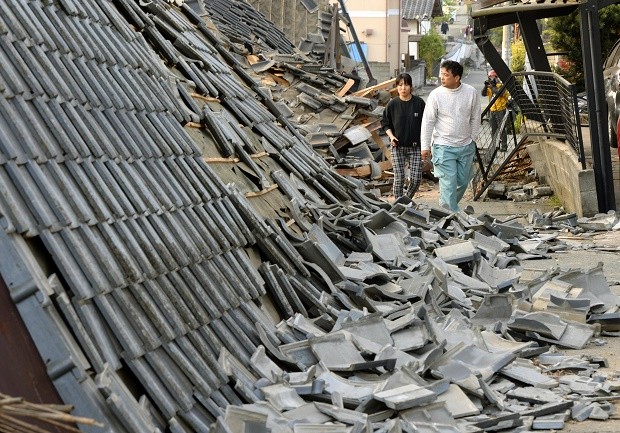Strong quake kills 9, injures more than 760 in Japan

Residents walk along collapsed houses in Mashiki, Kumamoto prefecture, southern Japan, Friday, April 15, 2016, after a magnitude-6.5 earthquake. The powerful earthquake struck Thursday night, knocking down houses and buckling roads. RYOSUKE UEMATSU/KYODO NEWS VIA AP
TOKYO — At least nine people were killed and 761 injured by a magnitude 6.5 earthquake Thursday night that toppled houses and buckled roads in southern Japan, the government’s chief spokesman said.
Yoshihide Suga said he would visit the area Friday to assess the damage. He said 1,600 soldiers had been deployed, and TV reports showed some delivering blankets and adult diapers to the thousands of people who took shelter because their homes were wrecked or unsafe.
About 44,000 people sought refuge, though some returned home in the morning.
READ: Powerful earthquake hits south Japan; some damage reported
The quake struck at 9:26 p.m. at a depth of 11 kilometers (7 miles) near Kumamoto city on the island of Kyushu, the Japan Meteorological Agency said. There was no tsunami risk.
Article continues after this advertisementThe area is 1,300 kilometers (800 miles) southwest of Tokyo.
Article continues after this advertisementThe worst damage was in the town of Mashiki, 15 kilometers (9 miles) east of Kumamoto city on the island of Kyushu, said Kumamoto prefecture disaster management official Takayuki Matsushita.
Suga said 44 of the injured were seriously hurt. Those killed ranged in age from 29 to 94. Most were elderly.
“The shaking was so violent I couldn’t stand still,” said Hironobu Kosaki, a Kumamoto Prefectural Police night-duty official.
Suga said at least 19 houses collapsed, and hundreds of calls came in reporting building damage and people buried under debris or trapped inside.
With daybreak, the extent of the damage was becoming apparent: collapsed walls, streets warped by manholes that were pushed higher by the earth’s movement, an expressway crunched and buckled.
Rescue operations were repeatedly disrupted by aftershocks. By early Friday there had been 116 such jolts strong enough to be felt.
“There was a ka-boom and the whole house shook violently sideways,” Takahiko Morita, a Mashiki resident said in a telephone interview with Japanese broadcaster NHK. “Furniture and bookshelves fell down, and books were all over the floor.”
Morita said some houses and walls collapsed in his neighborhood, and water supply had been cut off. Early Friday, residents were hauling water from local offices to their homes to flush toilets.
Local broadcasters were urging residents to check on elderly people living alone who might not be able to escape their homes unaided.
Suga said there no abnormalities at nearby nuclear facilities. The epicenter was 120 kilometers (74 miles) northeast of Kyushu Electric Power Co.’s Sendai nuclear plant, the only one operating in the country.
Most of Japan’s nuclear reactors remain offline following the meltdowns at the Tokyo Electric Power Co.’s Fukushima plant in 2011 after a magnitude 9.0 earthquake triggered a huge tsunami.
Television footage showed fires breaking out in some places, with firefighters battling an orange blaze.
Keisuke Urata, an official in nearby Uki city who was driving home when the quake struck, told NHK that parts of the ceiling at Uki City Hall collapsed, windows broke and cabinets fell to the ground.
There were multiple aftershocks, the largest one with a preliminary magnitude of 6.4 shortly after midnight, according to the Japan Meteorological Agency.
The U.S. Geological Survey measured the initial quake’s preliminary magnitude at 6.2. It upgraded its damage assessment to red, meaning extensive damage is probable and the disaster likely widespread.
According to the Japan Meteorological Agency, Mashiki sits near two faults on Kyushu. The area is also near Mount Aso, a huge, active volcano. JMA officials said the quake was unusually strong for Kyushu.
Footage from an NHK bureau in the area showed books, files and papers raining down to the floor. One employee appeared to have fallen off a chair, while others slid under their desks to protect their heads.